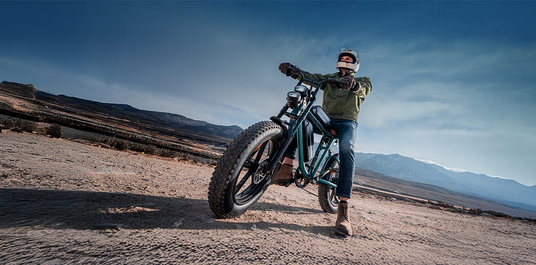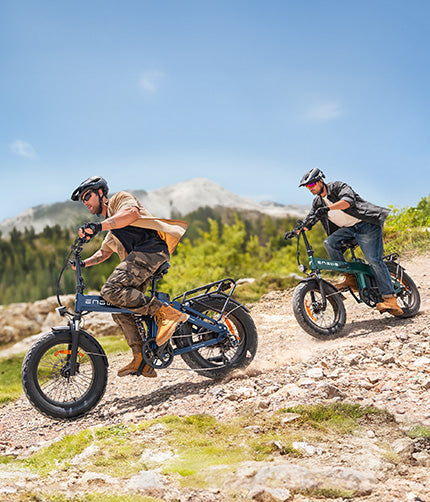The modern world demands versatility, and nowhere is this more true than in how we choose to travel and explore. You might find yourself rattling over cobbled city streets one moment and eyeing a tempting dirt track the next. This is the exact scenario where the limitations of conventional bikes become frustratingly clear. A road bike shudders, a standard mountain bike can feel sluggish on tarmac, and a simple commuter electric bike lacks the grit for true adventure. This is where a new breed of machine comes into its own, promising a solution not of compromise, but of total capability. Imagine gliding over potholes, maintaining unshakeable grip on loose gravel, and conquering steep hills without breaking a sweat. This isn't a fantasy; it's the daily reality offered by a full suspension fat tire electric bike.
Beyond the Hype: What Are You Truly Getting?
At first glance, the name "full suspension fat tire electric bike" seems like a mouthful, but it perfectly describes a trinity of technologies working in perfect harmony. Let's break it down. First, the "electric bike" component: a motor and battery that provide power assistance as you pedal, turning daunting inclines into manageable slopes and long distances into enjoyable journeys. Second, the "fat tire" aspect: these wide, chunky tyres, typically 4 inches across or more, run at a lower pressure than standard bike tyres. This creates a larger contact patch with the ground, offering incredible grip on unstable surfaces like sand, mud, and loose stones, while also providing a natural cushioning effect. Finally, "full suspension": this is the game changer. Unlike bikes with only front suspension (hardtails), a full suspension setup has shock absorbers on both the front and rear wheels. This system is designed to absorb impacts from both wheels, effectively isolating you from the roughest terrain and keeping your tyres planted on the ground for maximum control and comfort.
The Unmatched Comfort and Go-Anywhere Freedom
The primary reason riders gravitate towards this type of bike is the revolutionary ride quality. The combination of the fat tyres' cushioning effect and the active work of the front and rear suspension creates a sensation often described as "floating" over obstacles. Potholes that would jolt your spine on a regular bike are reduced to minor bumps. Uneven trails, tree roots, and rocky paths are smoothed out, allowing you to ride for longer without the associated fatigue and discomfort. This isn't just about comfort; it's about control and confidence. When the bike is absorbing the bumps instead of your body, you can focus on your line, enjoy the scenery, and push your boundaries. It transforms a jarring commute into a pleasant glide and opens up a world of weekend exploration that was previously reserved for highly specialised, non-electric mountain bikes.

Who is This Ultimate All-Terrain Machine For?
While it might seem like a niche product, the appeal of a full suspension fat tire e-bike is surprisingly broad. It is the perfect choice for the urban explorer who contends with a patchwork of poorly maintained roads, kerbs, and the occasional park shortcut. The suspension and tyres handle the urban jungle with ease, providing a safe and supremely comfortable commute. It's also ideal for the weekend adventurer who wants one bike that can do it all, from a leisurely ride along a canal towpath to a more ambitious journey through a forest trail. Furthermore, it's an excellent option for riders seeking maximum comfort, including those with back or joint issues, as the dual suspension system minimises the jarring impacts that can cause pain. It's a bike for anyone who refuses to be limited by terrain and who values comfort as much as capability.
A Standout Choice: The ENGWE EP-2 Boost
While many options exist, one model that expertly blends these features for the modern rider is the ENGWE EP-2 Boost. This foldable electric bike is a masterclass in practical design and powerful performance. Its EU-legal 250W brushless motor is enhanced by a sophisticated torque sensor, which provides an incredibly smooth and intuitive level of power assist that feels like a natural extension of your own effort. For those moments when you face a particularly steep challenge, a simple press of the Boost button unleashes an impressive 55Nm of torque, propelling you uphill with ease. The 20 x 4.0 fat tyres are mounted on durable one-piece wheels, offering superior stability and a maintenance-free advantage over traditional spoked wheels. The ride is further smoothed by a reliable front suspension system, working in concert with the SHIMANO 7-speed gears to ensure you're always in the perfect gear for the terrain. Practicality is at its core; the EP-2 Boost features a smart foldable frame, a removable 48V 13Ah battery that delivers a remarkable range of up to 120km, and the stopping power of 180mm front and rear mechanical disc brakes. It’s a complete package that delivers on the promise of go-anywhere freedom.

Decoding the Tech and Practical Realities
Decoding the Tech: Key Features to Scrutinise
When you start comparing models, it’s easy to get lost in technical specifications. Focus on the elements that have the biggest impact on your ride. For the motor, look beyond just the Wattage (W) and pay attention to the torque, measured in Newton-metres (Nm). Torque is the rotational force that gets you moving and helps you climb hills; a higher Nm figure is generally better for challenging terrain. For the battery, its capacity (measured in Amp-hours or Ah) will be the biggest determinant of your range. A larger Ah number means you can travel further on a single charge. Finally, don't overlook the brakes. Given the extra weight and speed of an electric bike, powerful and reliable disc brakes are not a luxury, they are a necessity for your safety.
The Practical Realities: Weight, Size, and Maintenance
It's important to approach ownership with a realistic perspective. The combination of a motor, battery, robust frame, and full suspension system means these bikes are significantly heavier than their non-electric counterparts. A typical weight is around 30 kg, so lifting one onto a bike rack or carrying it up a flight of stairs can be a challenge, even with a folding design. Storage can also be a consideration, as the fat tyres make them wider than a standard bicycle. Maintenance is another factor; while generally reliable, a full suspension system has more moving parts (pivots and bushings) than a standard bike, which may require occasional servicing by a professional to keep it performing optimally. However, for the unparalleled comfort and capability they provide, most owners see these as very worthwhile trade-offs.
A full suspension fat tire electric bike is your key to unlocking a new level of riding freedom, turning every journey into a smooth and confident adventure.

Your Top 5 Questions Answered
1. How fast can a full suspension fat tire electric bike legally go?
In the UK and EU, the law for electric bikes is very specific. The motor is only allowed to provide assistance up to a speed of 25 km/h (15.5 mph). You can pedal the bike faster than this using your own power, but the motor will cut out at that speed limit. This ensures the bike is classified as an electrically assisted pedal cycle (EAPC) and doesn't require a license, tax, or insurance.
2. The advertised range seems very high. What is a realistic range I can expect?
The maximum range, like the 120km advertised for the ENGWE EP-2 Boost, is calculated under ideal conditions. This usually means using the lowest level of pedal assist (PAS 1), on flat terrain, with a lightweight rider and no headwind. In the real world, your range will be affected by factors like your weight, the hilliness of your route, the level of assistance you use, and even tyre pressure. A more realistic expectation for mixed-use riding is typically 60-80% of the maximum stated range, which is still a very substantial distance for most daily rides and adventures.
3. Is a bike like this difficult to maintain?
While more complex than a simple pushbike, maintenance is manageable. The core tasks are the same as any bicycle: keep the tyres inflated to the correct pressure, keep the chain clean and lubricated, and check your brake pads for wear. The electric components are generally sealed and require no regular maintenance. The only additional consideration is the suspension, which may benefit from a professional service every year or two, depending on how hard you ride, to keep it working smoothly.
4. How do I charge the battery, and how long does it take?
Most modern fat tire e-bikes, including the ENGWE EP-2 Boost, feature a removable battery. This is a huge convenience. You can unlock and slide the battery out of the frame and take it indoors to charge using a standard wall socket. This not only makes charging easier but also enhances security, as you can store the valuable battery separately from the bike. A full charge from empty typically takes around 6 to 7 hours, making it easy to charge overnight and be ready for the next day's ride.
5. I am a heavier rider. Is this type of bike suitable for me?
Absolutely. In fact, they are often an excellent choice for heavier riders. The robust frames and strong wheels are built to handle tough conditions, which translates to a high maximum load capacity. For example, the ENGWE EP-2 Boost can support a total load of up to 150 kg (330 lbs). The combination of fat tyres and full suspension provides a much more comfortable and stable ride, while the electric motor provides crucial assistance, making cycling more accessible and enjoyable regardless of rider weight.









